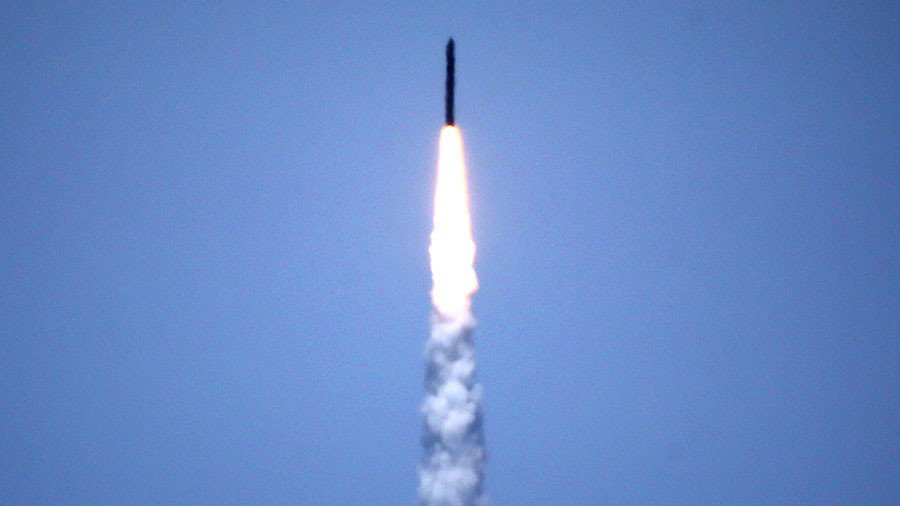‘This is not a drill’: Hawaii gets ballistic missile alert ‘by mistake’

A text warning of an imminent incoming ballistic missile, which urged residents to “seek immediate shelter” was “accidentally” issued by Hawaii Civil Defense, briefly stirring panic and confusion on social media.
The emergency alert, which popped up on mobile phones across Hawaii shortly after 8am local time, read: “BALLISTIC MISSILE THREAT INBOUND TO HAWAII. SEEK IMMEDIATE SHELTER. THIS IS NOT A DRILL.”
Just received this alert in Hawaii pic.twitter.com/VCHwRdG9Bc
— Amanda Golden (@amandawgolden) January 13, 2018
What?! A ballistic missile?! #Hawaiipic.twitter.com/TmSGaoIQ7i
— me~shell⚾ (@hawaiigirl3) January 13, 2018
The message prompted panic and confusion, both on the ground and on social media.
According to reports emerging on social media, some people even tried to seek shelter from the “incoming missile” in storm drains.
Brah @Hawaii_EMA you got fams out here putting their kids in the storm drains... Thanks a lot😂 pic.twitter.com/jxtxETf62M
— Nalü (@NaluRivera) 13 января 2018 г.
Emergency phone lines were reportedly clogged with calls following the alert.
Yeah deafly the scariest 22 minutes of my life when I can’t even get a hold of 911 operator and WE DID HEAR SIRENS! 🚨 #thatshitisnotfunny
— Momi MOE MEE Pearl☀️ (@MomiTrainHawaii) 13 января 2018 г.
Another Civil Defense message, reassuring Hawaiians that the original alert was in fact false, has reportedly only reached some citizens after long delays, apparently due to the strain the event has put on local phone lines.
38 minutes to get a FALSE ALARM...can u help fix this?! pic.twitter.com/KFYevrdCUD
— kelbel (@rottonroll) 13 января 2018 г.
In a statement posted on Twitter, Rep. Tulsi Gabbard said the alert was a false alarm.
“This is a false alarm. There’s no incoming missile to Hawaii. I have confirmed with officials there is no incoming missile,” she said.
HAWAII - THIS IS A FALSE ALARM. THERE IS NO INCOMING MISSILE TO HAWAII. I HAVE CONFIRMED WITH OFFICIALS THERE IS NO INCOMING MISSILE. pic.twitter.com/DxfTXIDOQs
— Tulsi Gabbard (@TulsiGabbard) January 13, 2018
It was some 30 minutes after the alert that the Hawaii Emergency Management Agency confirmed the missile threat was non-existent.
NO missile threat to Hawaii.
— Hawaii EMA (@Hawaii_EMA) January 13, 2018
EMA officials now saying on TV that the alert sent to people in Hawaii that said a “ballistic missile threat inbound to Hawaii ... this is not a drill” was actually a drill pic.twitter.com/2osOKDrzKa
— Michelle Broder Van Dyke (@michellebvd) January 13, 2018
The US military’s Pacific command has also reassured citizens it was a false alarm, confirming it had “detected no ballistic missile threat to Hawaii” and that the message had been “sent in error.”
U.S. Pacific Command has detected no ballistic missile threat to Hawaii. Earlier message was sent in error. State of Hawaii will send out a correction message as soon possible. pic.twitter.com/hqidbV0BWn
— U.S. Pacific Command (@PacificCommand) 13 января 2018 г.
The Federal Communications Commission (FCC) says it is launching a “full investigation” of the Hawaii missile alarm scare, with its head Ajit Pai calling the incident a “false emergency alert” on Twitter.
Meanwhile, the White House referred to the missile alert as “state exercise.” “The President has been briefed on the state of Hawaii’s emergency management exercise. This was purely a state exercise,” said White House spokeswoman Lindsay Walters.
The incident occurred during a shift changeover when an employee pushed the wrong button, Hawaii Governor David Ige said. The official apologized for the false alarm, calling it “unfortunate and regrettable.”
"It was a mistake made during a standard procedure at the change over of a shift, and an employee pushed the wrong button," he told CNN.
The incident has clearly shown that “government agencies are not prepared and lack the capacity to deal with emergency situations,” said Speaker for the Hawaii House of Representatives Scott Saiki. The system that Hawaiian residents are supposed to rely on failed miserably, as it took some 30 minutes for the emergency services to issue a correction, the official stressed.













